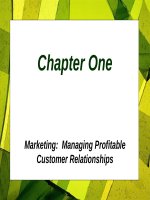Lecture Business and society - Chapter 1: The Business and Society Relationship
Bạn đang xem bản rút gọn của tài liệu. Xem và tải ngay bản đầy đủ của tài liệu tại đây (1.62 MB, 26 trang )
© 2015 Cengage Learning
1
Chapter 1
The Business
and Society
Relationship
© 2015 Cengage Learning
2
Learning Outcomes
1. Characterize business and society and their
2.
3.
4.
5.
6.
interrelationships.
Describe pluralism and identify its attributes, strengths,
and weaknesses.
Clarify how a pluralistic society becomes a specialinterest society.
Identify, discuss, and illustrate the factors leading up to
business criticism.
Pinpoint the major criticisms of business and
characterize business’s general response.
Describe the major themes of the book: managerial
approach, ethics, sustainability and stakeholder
© 2015 Cengage Learning
management.
3
Chapter Outline
•
•
•
•
•
•
•
•
•
•
Business and Society
Society as the Macroenvironment
A Pluralistic Society
A Special-Interest Society
Business Criticism and Corporate Response
Focus of the Book
Structure of the Book
Summary
Key Terms
Discussion Questions
© 2015 Cengage Learning
4
Business and Society
Business •the collection of private, commercially oriented
organizations ranging in size from one-person
proprietorships to corporate giants.
Society •a community, a nation, or a broad group of people
with common traditions, values, institutions, and
collective activities and interests.
Macroenvironment •the total environment outside the firm, the
comprehensive societal context in which the
organization resides.
Society
•is the macroenvironment in which businesses
operate. © 2015 Cengage Learning
5
Conceptualizing the
Macroenvironment
© 2015 Cengage Learning
6
Segments of the
Macroenvironment
© 2015 Cengage Learning
7
A Pluralistic Society • Prevents power from being concentrated in
the hands of a few.
• Maximizes freedom of expression and
action, and strikes a balance between
monism, on the one hand, and anarchy on
the other.
• Creates a widely diversified set of loyalties
to many organizations, and minimizes the
danger that a leader of any one
organization will be left uncontrolled.
• Provides a built-in set of checks and
balances, in that groups can exert power
over one another with no single
organization (business or government)
dominating and becoming overly influential.
© 2015 Cengage Learning
8
Business and Stakeholder
Relationships
© 2015 Cengage Learning
9
Special Interest Groups •
•
•
•
•
•
•
Make life more complex for business and
government.
Can number in the tens of thousands in
some societies.
Pursue their own focused agendas.
Are active, intense, diverse and focused.
Can attract a significant following.
Often work at cross purposes, with no
unified goals.
A special-interest society is pluralism
taken to the extreme.
© 2015 Cengage Learning
10
Social Environment, Business
Criticism and Corporate
Response
Affluence
Education
Awareness
Factors in the Social Environment
Rising Expectations
Rights Movement
Victimization
Philosophy
Entitlement
Mentality
Business Criticism
Increased Concern for the
Societal Environment
A Changed Social Contract
© 2015 Cengage Learning
11
Factors in the Social
Environment
Affluence and Education •Create higher expectations of major institutions.
•Growing public awareness through television,
movies, and the Internet.
The Revolution of rising expectations creates a social problem, a gap between
societal expectations for social conditions and
social realities. This can lead to:
• Entitlement mentality
• Rights movement
• Victimization philosophy
© 2015 Cengage Learning
12
Society’s Expectations Versus
Business’ Actual Social
Performance Society’s
Social Performance:
Expected and Actual
Expectations
of Business
Performance
Social Problem
Social
Problem
Business’s Actual
Social Performance
1960s
2010s
Time
© 2015 Cengage Learning
13
Business Criticism:
Use and Abuse of Power
Business Power •the ability or capacity to produce an
effect or to bring influence to bear on a
situation or people
Iron Law of Responsibility •In the long run, those who do not use
power in a manner society considers
responsible will tend to lose it
© 2015 Cengage Learning
14
Levels and Spheres of
Corporate Power
Level
Spheres s
Macro
Level
Intermediate
Level
Micro
Level
Individual
Level
The
business
system
Several firms
A single firm
A Single
Executive
Economic
Social/Cultural
Individual
Technological
Environmental
Political
© 2015 Cengage Learning
15
15
Elements in the Social Contract
Laws or Regulations:
“Rules of the Game”
Business
Two-Way
Shared
Understandings of
Each Other
© 2015 Cengage Learning
Society or
Societal
Stakeholder
Groups
16
Focus of the Book
Managerial
Approach
Business
Ethics
Sustainability
© 2015 Cengage Learning
Stakeholder
Management
17
A Managerial Approach
•
•
•
Managers are practical, and have begun
to deal with social and ethical concerns in
ways similar to those they use to manage
traditional business functions such as
marketing, finance, operations, & risk
management.
As a result, managers have been able to
convert seemingly unmanageable
concerns into ones that can be dealt with
in a balanced and impartial fashion.
At the same time, managers have had to
integrate traditional economic and
financial considerations with ethical and
social considerations.
© 2015 Cengage Learning
18
Urgent versus Enduring
Issues
Short-Term •Issues or crises arise on the spur of the
moment and management must formulate
quick responses.
Long-Term •Issues or problems are a long-term
concern and management must develop a
thoughtful organizational response.
© 2015 Cengage Learning
19
A Business Ethics Theme
Ethical questions •inevitably and continually come into play
during business operations.
Ethics •refers to issues of right, wrong, fairness, and
justice.
Business Ethics •focuses on ethical issues that arise in the
commercial realm.
Ethical questions •permeate business’s activities as it attempts
to interact with major stakeholder groups.
© 2015 Cengage Learning
20
A Sustainability Theme
Sustainability - Has become one of
businesses’ most pressing mandates.
Sustainable development - is a pattern of
resource use that aims to meet current needs
while preserving the environment for future
generations.
Sustainability embraces criteria which are:
•
•
•
Environmental
Economic
Social
Sustainability concerns the ability of
businesses to survive and thrive over the long
© 2015 Cengage Learning
21
term.
Stakeholder Management
Theme
Stakeholders •Individuals or groups with which business
interacts and who have a vested interest in the
firm.
•In this text, we consider:
• External stakeholders, such as
government, consumers, the natural
environment, community members
• Internal stakeholders, such as
employees, those involved in corporate
governance, and others.
© 2015 Cengage Learning
22
Structure of the Book (1 of 2)
Part One: Business, Society, and Stakeholders
1. The Business and Society Relationship
2. Corporate Citizenship: Social Responsibility, Performance
and Sustainability
3. The Stakeholder Approach to Business, Society, and
Ethics
Part Two: Corporate Governance & Strategic
Management Issues
4. Corporate Governance: Foundational Issues
5. Strategic Management and Corporate Public Policy
6. Issue, Risk and Crisis Management
© 2015 Cengage Learning
23
Structure of the Book (2 of 2)
Part Three: Business Ethics and Management
7. Business Ethics Fundamentals
8. Personal and Organizational Ethics
9. Business Ethics and Technology
10. Ethical Issues in the Global Arena
Part Four: External Stakeholder Issues
11. Business, Government, and Regulation
12. Business Influence on Government and Public Policy
13. Consumer Stakeholders: Information Issues and
Responses
14. Consumer Stakeholders: Product and Service Issues
15. Sustainability and the Natural Environment
16. Business© and
Community Stakeholders
2015 Cengage Learning
24
Organization and Flow of the
Book
Part Five: Internal Stakeholder Issues
17. Employee Stakeholders and Workplace Issues
18. Employee Stakeholders: Privacy, Safety, and Health
19. Employment Discrimination and Affirmative Action
Cases
© 2015 Cengage Learning
25









